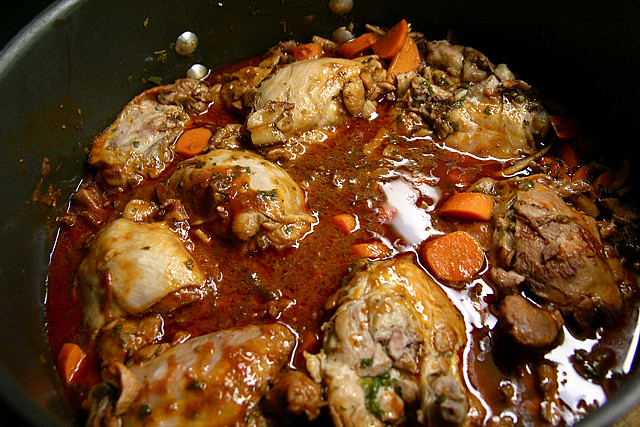Off late, I have become a big fan of Fox Traveler. The reason is but obvious - the channel features food shows back to back - Poh's Kitchen, Food Safari, Dolce Vita and Twist of Taste, making it my favourite channel, whenever the television is on at home.
In Saturday's edition of the Food Safari, the presenter, Maeve O’Meara covered traditional French cuisine which included an interesting part on a very traditional French preparation, coq au vin - poulet de Bresse (Bresse chicken) cooked with Burgundy wine, lardon, mushrooms and aromatic herbs.
The secret of an authentic coq au vin, as I gathered, lies in the coq or authentic poulet de Bresse - poultry that originates from the Bresse area of the Rhône-Alpes region of France. Raised in limited quantities, these birds are "highly valued for their gamey flavour, fine, tender flesh and delicious, clean-flowing fat" as Maeve described it.
The Bresse evokes a great degree of French nationalism. The coq is said to represent the colours of the tricolore or the French flag - a distinctive red crown, white feathers and blue feet, a national mascot of sorts! Under French Law, only the chicken reared in a certain area in Bresse can be certified as poulet de Bresse!
Such is the passion the French have for their food! Indeed, admirable!
The poulet is tended for, cared for, in exact and specific standards. Each bird is allocated a minimum of ten square meters. Diet and slaughter times are strictly controlled. Birds are required to spend their final days in an epinette, a building traditionally used for forced feeding with grain mash and milk. Probably that's what gives the poulet de Bresse its repute!
I just can't wait to visit the Rungis in Paris to lay my eyes on this very sexy bird(!), though buying it is another matter - it is said to cost €15 a kilo, that's over ₹1000(!), which is indeed quite a lot by our standards!
From what I saw on Maeve O’Meara's show, coq au vin seems to be a rustic but hearty preparation. The origins of coq au vin are ancient - from the times of the Romans and the Gauls! I wonder why Asterix and Obelix never had coq au vin?
The poulet de Bresse is marinated in Burgundy alongwith vegetables and a bouquet garni overnight. The poulet is then seared in lardon or bacon fat, then simmered with the marinade. Maeve's version of the dish involved the addition of finely minced liver to thicken the gravy. At the end, mushrooms were added. As I saw Maeve and her guest chef prepare the coq au vin, I had an uncontrollable urge to have it immediately!
Surely, besides being lip-smacking, hearty and having an avalanche of flavours, the dish itself seems to be quite healthy. French cuisine, while relying on a lot of red meats (coq au vin being an exception) uses wine extensively in cooking.
Wine is said to raise levels of HDL, the "good" cholesterol, and helps reduce the risk of blood clots forming in coronary arteries. Red wine (and the skin of red grapes) contains resveratrol, an antioxidant that has been shown to promote longevity in laboratory conditions and is believed to slow the progress of age-related diseases, including diabetes, cancer and Alzheimer's. Besides these benefits, cooking with wine certainly does enhance the flavour, while at the same time neutralising the ill-effects of the fats that go into this dish.
Julia Child, the legendary American chef and food-writer (who was immortalised in the enjoyable 2009 Hollywood film, Julie & Julia?), is said to have popularised coq au vin across the Atlantic. Probably, its time someone did the same in India. Given India's (or probably the Punjabis') love for the bird, our Indianised version of coq au vin with garam masala and turmeric a good measure of hearty Scotch thrown in to replace the Burgundy, there is a decent chance our Scotch da Kukkad will excite the Indian palette!
As for me, the one closest to the authentic would do! I would rather rush to get a bottle of Burgundy and Godrej Real Good chicken (that's the best I can do here!) and conjure up some French magic in the kitchen!
































